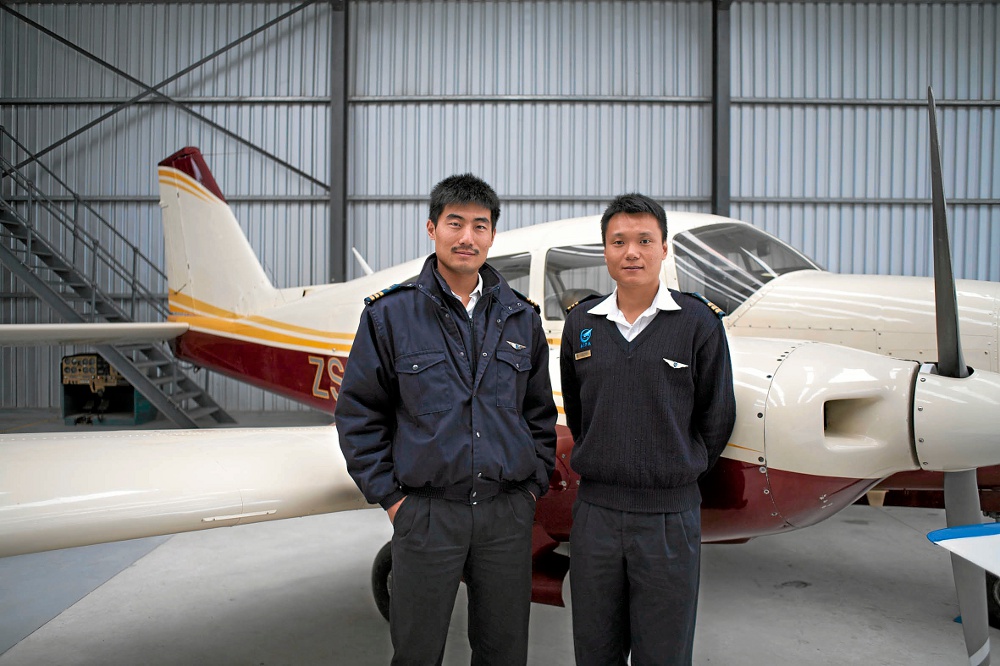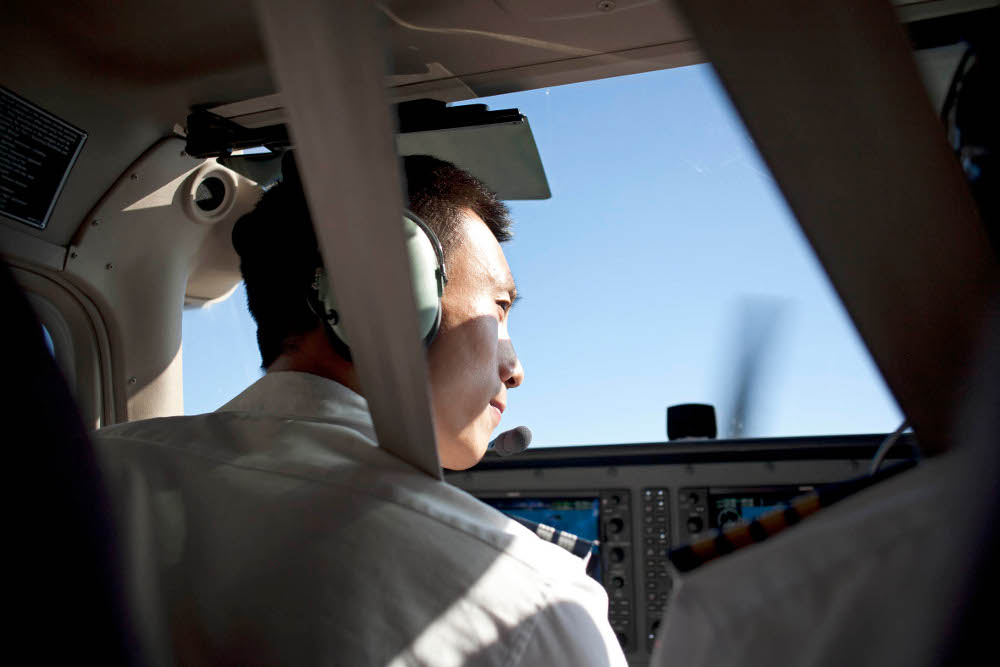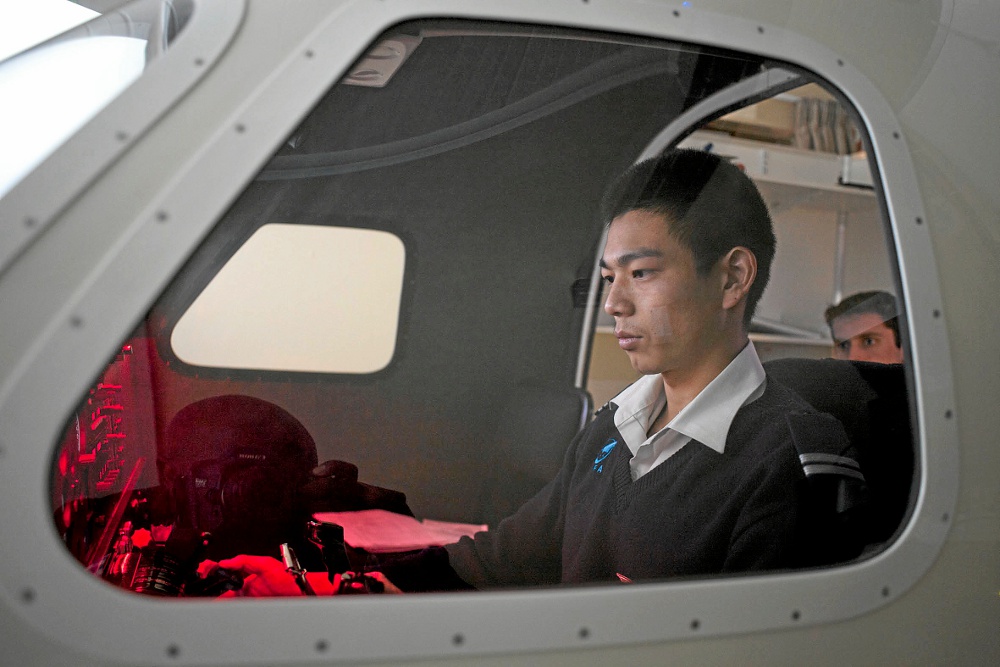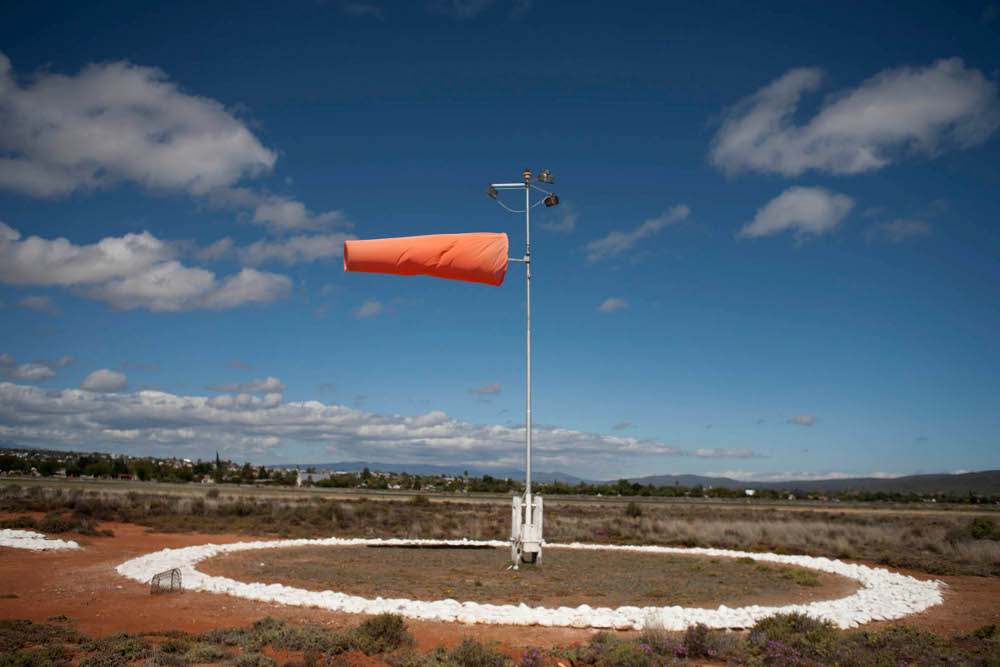Flying instructor Moeketsi Mpaka follows a Chinese cadet
Liu Chang is dressed neatly in navy trousers and a white shirt, adorned with navy and silver epaulettes on each shoulder, and looks every inch the pilot. You would never have guessed he hadn’t planned to become one.
The 23-year-old, who introduces himself as Roy, grew up in the chilly Jilin province in northeast China, where his mother works in a rubbing alcohol factory, and left for the Nanjing University of Aeronautics and Astronautics, 2 000km south of Beijing, to study mathematics.
“I didn’t have a plan. Maths is very difficult and I don’t like it,” he says. “You can’t find a good job. It is very difficult.”
When he was approached to try his luck at a full-paid scholarship to become a commercial airline pilot, he jumped at the opportunity. By passing the stringent medical, English and psychological tests, he was able to start on aviation theory – before being selected to go to the Avic International Flight Training Academy (Aifa) in Oudtshoorn, an area better known for ostrich farming than for flight training, to get his private pilot’s licence and additional qualifications.
Avic, the Aviation Industry Corporation of China, is a Chinese state-owned aerospace and defence company and holds a 70% stake in the academy, which has bases in Oudtshoorn and George. In the new year, it will also train cadets in Beaufort West. The other 30% is held by the Test Flying Academy of South Africa.
Chinese aviation
Liu is one of a group of 107 cadets currently at the academy, most of whom had a similar experience in finding themselves at Nanjing University.
“Aviation in China is developing at a pace second to none in the world with the airspace opening up,” says Willem Marais, the chief executive of the academy.
At the Aifa base, near the George airport, the sound of planes taking off and landing make a persistent ambient sound.

Wei Gee and Jian Wang were among the select few to end up at the Avic academy. (Photos: Oupa Nkosi, M&G)
“It [China] was a communist country and everything was controlled by government. General aviation was small, and privately owned aircraft were not possible for many years,” says Marais.
The Chinese national civil aviation authority estimates 500 000 civilian pilots will be needed by 2035.
“If I just look at the orders the Chinese airlines have placed – they don’t buy two or three Boeings, they buy 50 at a time,” Marais says.
Limited expertise
Given the limited expertise in the country, China has been able to train only about 1 500 pilots. Although its capacity is increasing, it is not growing at the same rate as demand and so training academies in the United States, Australia, South Africa and Canada have been used.
But the Chinese government decided to train cadets only at schools in which it is a shareholder. So 70% of the school was sold before it even opened its doors in 2010 to secure a share of the market, Marais says. It received its first group of 29 Chinese cadets from Beijing Capital Airlines in 2010 and today the academy trains pilots for several Chinese airlines.
“Over many years, South Africa established itself to do flight training that compares to the best in the world,” Marais says.
Political leader Jan Smuts established the first flight training academy near Kimberley in 1913, just 10 years after the Wright brothers had built the first successful plane. In 1920, the South African Air Force was formed.
“In South Africa, 30 years back, probably 95% of the pilots that flew here were military trained,” says Marais, a former South African Air Force pilot.
The academy has trained 76 pilots for the Chinese market, with the group of 107 now returning to China in batches as they complete their training.
Pilot recruitment
Once a year, the airline companies go to Nanjing University, which has about 26 000 students, to recruit pilots. The students undergo rigorous selection procedures and stay on at the university to study aviation theory.
In their third year, Aifa sends out a panel, which includes Marais, to select cadets for practical training in April and October each year.
During the 57 weeks that the cadets spend in South Africa, they need to get enough flying hours, obtain a private pilot’s licence, and instrument, night and multiengine ratings. The South African requirement is 200 flying hours, but each cadet gets 233 hours at the academy. To pass, they also need level four (advanced) English, which is required by the International Civil Aviation Organisation.

‘Marvin’ Wang Dang, like the other cadets, has to clock up 233 hours of flying.
The cadets are issued with South African licences, which have to be converted in China before they begin in-house training with the airline companies.
“The first group we sent back in early 2012, the group of 29, they have just started as first officers [copilots] with the airline. They will fly for another five to eight years before they do the in-house upgrade to become an airline captain.”
If you can get through the strict selection process and demanding training, “it’s a guaranteed job and a well-paid job. In China, it’s probably one of the best-paid jobs. It’s only a select group that get the opportunity,” Marais says.
The sponsoring airlines often lock the pilots into extended contracts.
‘Lifelong’ commitment
Zheng Chnag’an, who studied engineering at Nanjing before being recruited, will return home soon. “I will then go to my company. We sign working for this company for 25 years.” He pauses. “It’s quite long, almost a life.”
Liu reacts with amusement when asked if his contract is the same. “No no, no, we have different contracts. For me, its 35 years.” He grins.
Most of the students are from rural China, often with a family background in farming, and the plane to South Africa is often the first they set eyes on close up, let alone fly in.
“The first 20 and 30 hours is used to prepare the guy to do his first solo flight. Then you really want to fly in perfect weather conditions – clear blue skies with no wind,” says Marais.
Oudtshoorn, with 330 days of sunshine a year, is not a bad place to be.
“After that, he does his solo flight, 15 hours alone in an aircraft. The remainder of their training is to get their 233 hours, which is all done with an instructor.
“The fact we have a fixed contract with the Nanjing University probably makes us unique. But we are not the only flight school in South Africa that trains people from the Far East. That’s the market.”
Gauteng school
Gauteng’s Heidelberg Flight School and the 43 Air School in Port Alfred also train pilots for the Asian market.
Kenya Airways sends groups of about 12 cadets, twice a year, to train at Aifa. Local cadets also train at the academy but have to pay for it. At about R2 500 an hour to fly, it’s not cheap. Seventeen South Africans are currently training at Aifa.
“It would probably cost you R700 000 to train as a commercial pilot if you stay on campus for 57 weeks. It’s costly. If an opportunity comes from an airline, it’s pretty scarce. South Africa has a very small market,” Marais says.

A trainee goes through his paces in a flight simulator at the Avic academy.
Even then, the market is saturated and opportunities to gain experience are limited. The academy employs 130 people, which will rise to 160 in the new year. Of them, 64 are instructors at the two bases, 35 of whom have been trained here, with more to come on board at Beaufort West in January.
Instructing at the academy is a stepping stone for many local pilots.
“The problem is, once you qualify as a commercial pilot, you have 200 hours, a multiengine commercial licence, with no experience,” says Marais.
“And our market unfortunately is such that there are very few jobs, so the only way to build experience is to become a flight instructor and instruct until you have 1?500 to 2?000 flying hours total time and then you become more marketable.”
Instructor training
Aifa also trains Chinese cadets to become instructors. Wei Gee has been at the academy for three years and, having been through the programme, instructs cadets and is funded by Avic.
Wei was studying at Nanjing to become a physical education teacher, “and also now I’m a teacher”, he says, laughing.
Asked if the local cadets and instructors picked up any Mandarin, Jian Wang, who calls himself Tom (“Tom Cruise, you know, Top Gun“) and is also an instructor, says: “Do they pick up? Yes, some of them. They swear a lot.”
For those like Jian and Wei who will be in South Africa for several years, they have a car and hobbies. Jian has joined the George table tennis club and Wei the badminton club. “There was only one club. It is not a big sport in South Africa,” he says. “We go hiking. And we go to gym. A lot,” Jian says.
The cadets are given mainly Chinese meals. Eating stir fry out of a polystyrene container in the canteen at the George base, a cadet who goes by the name of Rice, says the food is good but “not as good as at home”. Liu says it’s okay but “it’s not Chinese food”.
Health and safety
The flight school racks up more than 30 000 hours of flying a year, which has not gone unnoticed and is not without controversy, at least not in Oudtshoorn where some residents are concerned about health, safety and noise.
“Schoolchildren are being exposed to totally unjustified health and safety dangers and, during exams, struggle to concentrate as twin-engine training aircraft perform low-level take-off and landing circuits as often as once every minute … directly above schools,” say Oudtshoorn residents Graham and Lizanne Pelham. She is the chairperson of the Oudtshoorn Ratepayers’ Association.
They claim that, despite the South African Civil Aviation Authority classifying this activity as “dangerous”?, flight training takes place directly over Oudtshoorn’s business and residential areas.

Weather conditions in the southern Cape favour training pilots.
The association says the Western Cape provincial government has been unresponsive about their concerns and appears to be siding with the academy and Chinese investors.
But Marais says training areas are generally out of town and that the concerned residents consist of only five people. Furthermore, a noise study was conducted, an environmental impact assessment is ongoing and the South African Civil Aviation Authority makes regular unannounced visits.
The local municipality has been in turmoil since the ANC lost its majority in 2013 and it has refused to give up power to the Democratic Alliance and Cope. The parties have been dragging each other in and out of court since August last year.
Academy lease
Because of the political infighting, securing a lease for the academy was delayed. “The municipal manager changed about five times since 2010,” Marais says.
But it recently signed a 10-year lease agreement. “It’s backdated and we had to pay a substantial amount for rent in arrears,” he says.
In George and Oudtshoorn, a long-term lease requires that any infrastructure built on the land become the property of the landlord if, for some reason, the contract is not renewed. In Oudtshoorn, R12-million has been invested in building the hanger and offices, Marais says.
There have been other economic spin-offs. The academy has bought accommodation in the Oudtshoorn area to house cadets and has contracts with hotels and guesthouses. In George, accommodation is outsourced and caterers provide lunch for staff and students. The academy has also formed a maintenance company for the aircraft and technicians receive on-the-job training.
The cadets long to go home but admit they will miss South Africa.
Wei is torn between what he will miss most, pizza or braai. “Quality of pizza in China. When I go back I never want to eat pizza again. Red wine here also good,” he says.
“I have a girlfriend. I will marry her when I go back to China. After I become a copilot,” says Liu. “I will really miss George, the beach. The sea is very blue, I like it. Don’t have sea in my home town and, in China, the sea is not very clean in some places.”